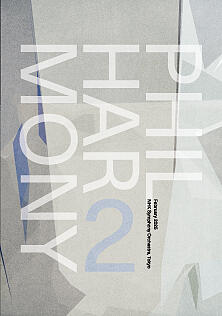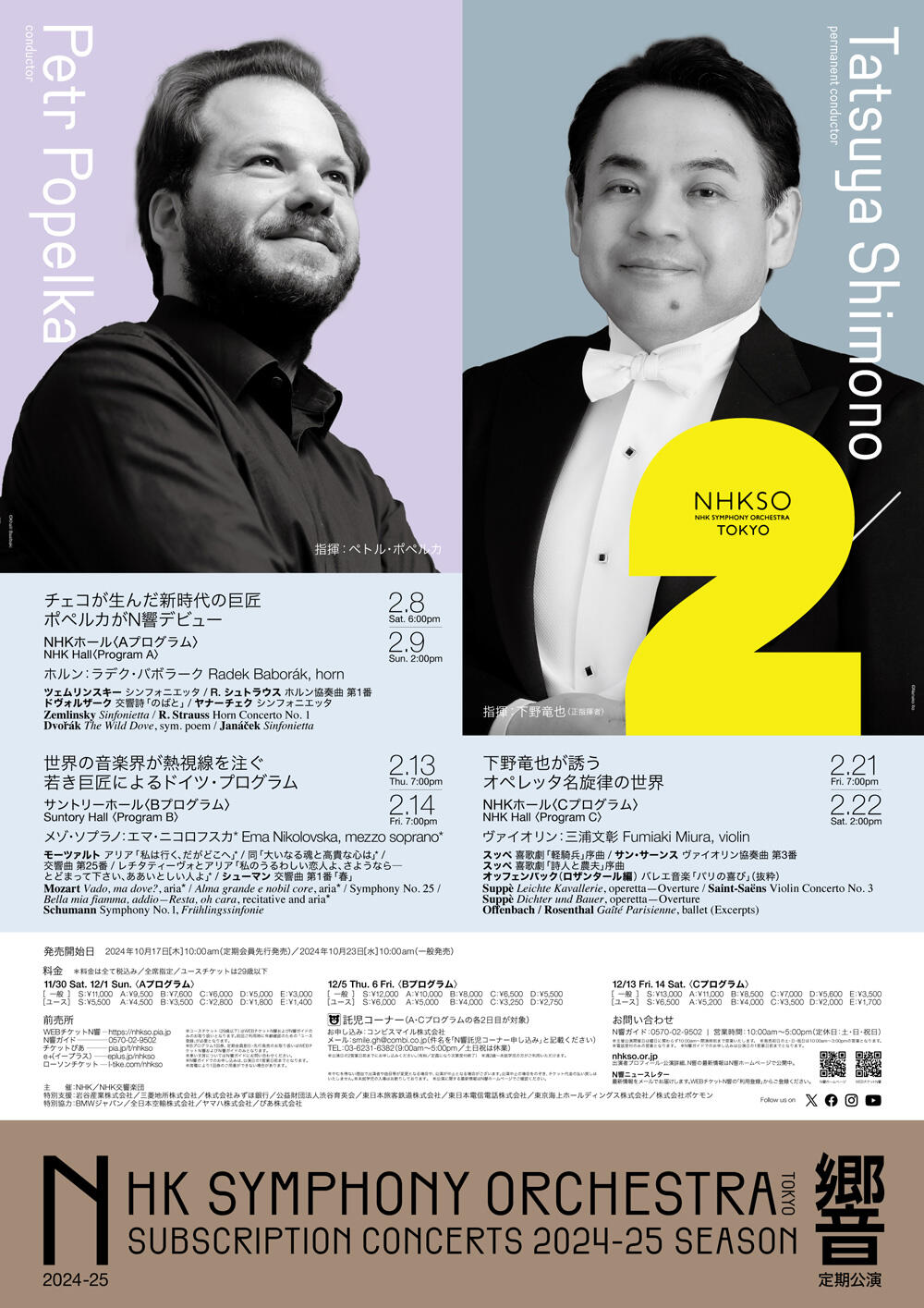- Home
- Concerts
- Subscription Concerts 2024-2025
- Program A
- No. 2031 Subscription (Program A)
No. 2031 Subscription (Program A)
NHK Hall
Google Map Seating Chart
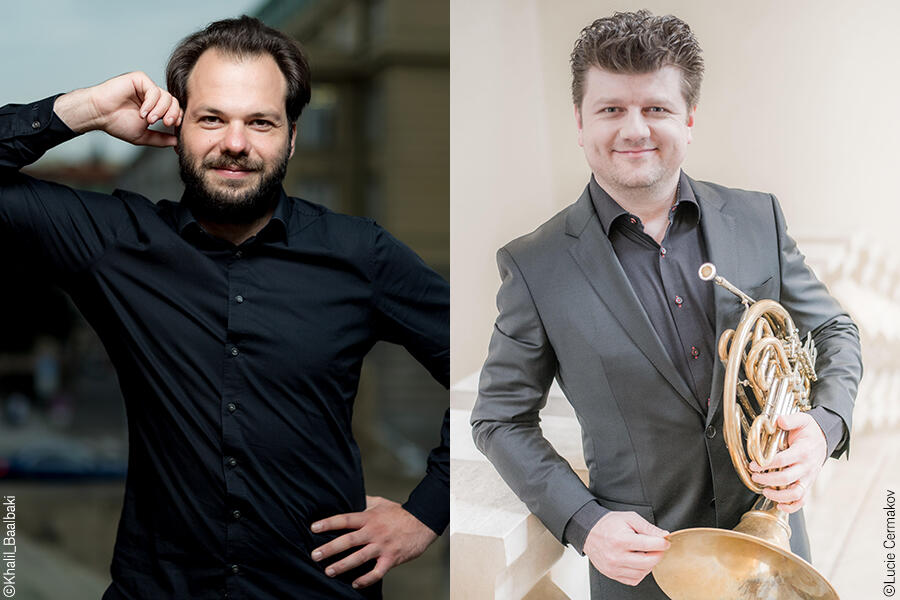
Program
Zemlinsky / Sinfonietta Op. 23
Alexander Zemlinsky (1871–1942), born to Jewish parents in Vienna, was known more as a leading conductor than a composer during his lifetime (he was the first Kapellmeister of the newly founded Vienna Volksoper), although his works such as Lyric Symphony (1923) have been performed more and more frequently in later days. Overall, his chromatically-expanded harmonic style follows Mahler (1860–1911) and Richard Strauss (discussed below) remaining in the traditional tonal language. Unlike Schönberg (1874–1951) who was Zemlinsky’s composition pupil and brother-in-law (his sister married Schönberg), he never adopted the novel twelve-tone technique.
When it comes to Zemlinsky’s relation to the Czech musical world which is an essential element of today’s concert, he contributed much to the development of Prague’s musical culture from 1911 to 1927 as the music director of the New German Theater (later renamed the Prague State Opera) and a guest conductor of the Czech Philharmonic Orchestra. During this period, Zemlinsky conducted important compositions by Smetana (1824–1884) and Janáček (described below) before moving to Berlin.
To flee from Nazi Berlin, Zemlinsky moved back to Vienna in 1933. Sinfonietta (meaning “little symphony”) was written the next year in response to a proposal from the Austrian publisher Universal Edition and first performed in Prague in 1935. It is composed of three fast-slow-fast movements. The lively outer movements both in D major, piquant and even cynical at times, evokes his contemporaries Hindemith and Stravinsky, while the central movement in B-flat minor entitled Ballade reminds us of Mahler with its late-Romantic dismal, melodious emotiveness.
[Kumiko Nishi]
R. Strauss / Horn Concerto No. 1 E-flat Major Op. 11
The Munich-born composer Richard Strauss (1864–1949)’s oeuvre is abundant in notable passages for French horn(s), with his Ein Heldenleben (A Hero's Life) and Eine Alpensinfonie (An Alpine Symphony) springing to mind. His earliest memory of the instrument is unmistakably linked to his father Franz (1822–1905), a historic horn virtuoso who served as the principal hornist at the prestigious Munich Court Orchestra. A precocious musical genius, his son began to compose at age 6. Guided by his father’s conservative taste, Strauss’s earliest compositions were modeled after Haydn, Mozart, Beethoven and Schubert. Renowned for his anti-Wagner stance, Strauss’s father is said to have kept a close watch on his son’s works still in the early 1880s.
Strauss penned the Horn Concerto No. 1 in 1882–1883 to celebrate his father’s 60th birthday, although the latter never performed it in public most likely due to old age. Commentators have often pointed out that it is influenced by Mozart and Mendelssohn but also the Horn Concerto in C minor written by Strauss’s father, while the young Strauss in his late teens surely intersperses the score with his own voice.
Performed without break, the concerto’s three movements share some common motifs. Opened immediately by the soloist announcing the principal theme evoking a hunting call, the first movement is a flexible rondo instead of a sonata. The darker next movement in A–B–A´ form lets the horn sing sonorously during its middle section. The spirited finale in 6/8 meter, again a rondo, accelerates toward the end to conclude the concerto with jaunty steps.
[Kumiko Nishi]
Dvořák / The Wild Dove, sym. poem Op. 110
An important figure of Czech national school in music, Antonín Dvořák (1841–1904) was born near Prague in Bohemia (the western part of the Czech Republic nowadays) then ruled by the Austrian Empire. Three years he spent in the United States were to further enrich his already matured style, as represented by his Symphony No. 9 From the New World (1893).
Dvořák returned from America to Bohemia in 1895 having nine years left until he passed away in Prague. From this final period, The Wild Dove (1896) is a symphonic poem based on a ballad of the same title by Czech national poet K. J. Erben (1811–1870). The first performance was given in 1898 under the baton of Janáček (mentioned below).
The Wild Dove in a single-movement has five sections of different tempos and moods following meticulously the ballad’s plot. During the opening section, we hear a funeral procession of a man whose widow sheds fake tears as she actually killed him with poison. The next A-major section’s jaunty trumpet melody represents a young man. The third C-major section in triple time is a scherzo describing the wedding celebration of the widow and the young man. During the next slow section in F minor, the woman hears a dove (flutes) cooing sorrowfully and obstinately on the grave of her former husband. She, racked by guilt, runs mad and commits suicide. The final section has the opening funeral music return, this time for the woman.
[Kumiko Nishi]
Janáček / Sinfonietta
A thirteen-year junior to Dvořák, Leoš Janáček (1854–1928) was born in Moravia (the eastern part of the Czech Republic today) then a part of the Austrian Empire. He first received musical education in Brno, Moravia’s capital, before studying organ in Prague where he met Dvořák. Trained at Leipzig’s and Vienna’s Conservatories in the early 1880s, Janáček began to have a passion for the study of Moravian folk songs and dances in the late 1880s, which would deeply influence his classical compositions marked by metrical/rhythmical individuality and intense contrast of sonority. A late bloomer, he won international fame in his sixties in 1916 when his opera Jenůfa (1904) was first staged in Prague with much success.
Then in 1918, an earnest wish of Janáček—and his compatriots—was fulfilled immediately after World War I ended: the independence of Czechoslovakia. He composed Sinfonietta in 1926 for Prague’s Sokol Festival (Sokol is a gymnastic society established by Czech patriots in Prague), intending at first to dedicate it to the new Czechoslovak Army. According to the composer’s own words, the work honors “contemporary free man, his spiritual beauty and joy, his strength, courage and determination to fight for victory.” Sinfonietta is a homage to Brno as well, as originally, each movement (except for the opening one) had a title related to the sights of the city: I Fanfare / II The Castle, Brno / III The Queen’s Monastery, Brno / IV The Street Leading to the Castle / V The Town Hall, Brno.
Sinfonietta is, despite the title (meaning “little symphony”), Janáček’s biggest purely instrumental piece. It is scored for an orchestra and an additional brass band which is composed of nine trumpets, two bass trumpets and two tenor tubas. Against the norm, the main orchestra—the single exception is timpani—remains silent during the opening movement performed by the brass band alone. It is only toward the end of the final movement that the brass band returns in an impressive manner, this time to play together with the entire main orchestra.
[Kumiko Nishi]
[Encore]
February 8: Radek Baborák / Jagd Fanfare
February 9: Astor Piazzolla / TANGO ETUDES - No.4 Meditativo
Horn : Radek Baborák
Artists
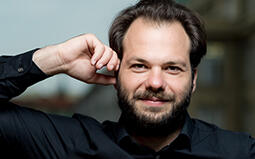 ConductorPetr Popelka
ConductorPetr Popelka
Czech conductor Petr Popelka is now taking Europe and America by storm. In the first five years since the start of his career as a conductor, he has served as Chief Conductor of three orchestras. Considering his talent and competence, he will certainly be promoted to further positions.
Born in Prague in 1986, he served as Deputy Principal Double Bassist of the Sächsische Staatskapelle Dresden for nine years from 2010. It was in 2019 when he started his full-fledged conducting career, and since then, he has stepped onto the podium of many renowned orchestras, achieving remarkable success. From 2020 to 2023, he was Chief Conductor of the Norwegian Radio Orchestra, and became Chief Conductor and Artistic Director of the Prague Radio Symphony Orchestra in 2022. He has also assumed the position of Chief Conductor of the Wiener Symphoniker from the 2024 season.
He made his debut in Japan by guest-conducting the Tokyo Symphony Orchestra in 2022, successfully bringing the orchestra together in a short period of time, very delicately creating sounds and performing in a grand scale, for which he won critical acclaim. He returned to Japan in 2024 with the Prague Radio Symphony Orchestra on its Japan tour.
On this first collaboration with the NHK Symphony Orchestra, he will conduct two subscription programs. In Program A, which includes Sinfonietta by both Zemlinsky and Janáček, he will clearly depict the style and shape unique to each work, while in Program B of Mozart and Schumann, we can expect to hear a well-balanced perfect performance based on the solid structure and good flow.
[Suzuki Atsufumi, music critic]
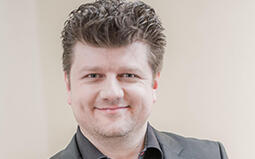 HornRadek Baborák
HornRadek Baborák
Czech virtuoso Radek Baborák, born in 1976, worked with the NHK Symphony Orchestra in the September Subscription concert in 2018. He started learning horn at the age of eight, and studied with Bedřich Tylšar at the Prague Conservatoire. He quickly started to win various competitions, and after winning the prestigious ARD International Music Competition Munich in 1994, he gathered world attention as a prodigy of horn. He served as solo horn player of the Münchner Philharmoniker and the Berliner Philharmoniker, while as a soloist, he performed worldwide, working with the Berliner Philharmoniker, Wiener Philharmoniker, and Symphonieorchester des Bayerischen Rundfunks.
He has also poured energy into the field of chamber music, performing in the Afflatus Quintet, a woodwind quintet he formed with his Czech friends, and the Baborák Ensemble, and has collaborated with masterly players of the world. He is also actively making recordings, releasing a wide discography from major labels of many countries. In recent years, he has launched a conducting career and has guest-conducted the Saito Kinen Orchestra and Mito Chamber Orchestra, and now serves as Music Partner of the Yamagata Symphony Orchestra.
[Takuya Katagiri, music critic]
Download
Ticket
Program A
No. 2031 Subscription (Program A)
NHK Hall
Google Map
Seating Chart
Single Tickets Release Date
Pre-sales for Subscribers:Thursday, October 17, 2024
*about subscribers
Sale to General Public:Wednesday, October 23, 2024
Price
| S | A | B | C | D | E | |
|---|---|---|---|---|---|---|
| Ordinary Ticket | 10,000 | 8,500 | 6,500 | 5,400 | 4,300 | 2,200 |
| Youth Ticket | 5,000 | 4,000 | 3,100 | 2,550 | 1,500 | 1,000 |
Seating chart Enlarge Print PDF
*tax included
*Subscribers receive a 10% discount (Available at NHKSO WEB Ticket and N-Kyo Guide)
*For wheelchair-accessible seats, please refer to the N-Kyo Guide
Youth Tickets
Youth Tickets are great options for those of 29 years old and younger
Subscription tickets
Release Date
ANNUAL SUBSCRIPTION TICKETS
Mon., July 15, 2024 10:00am
[For Subscribers: Sun., July 7, 2024 10:00am]
SEASONAL SUBSCRIPTION TICKETS (WINTER)
Tue., October 15, 2024 10:00am
[For Subscribers: Thu., October 10, 2024 10:00am]
Where to buy
NHKSO WEB Ticket | Saturday, February 8 (In English / Seats not selectable)
NHKSO WEB Ticket | Sunday, February 9 (In English / Seats not selectable)
NHKSO WEB Ticket (In Japanese only / Seats selectable)
N-Kyo Guide (Purchase by telephone only)
Other Ticket Agents
Broadcast
 NHK-FMNo. 2031 Subscription (Program A)
NHK-FMNo. 2031 Subscription (Program A)
Thursday, Feb 27, 2025 7:30PM - 9:10PM
Program:
Zemlinsky / Sinfonietta Op. 23
R. Strauss / Horn Concerto No. 1 E-flat Major Op. 11
Dvořák / The Wild Dove, sym. poem Op. 110
Janáček / Sinfonietta
Conductor:Petr Popelka
Horn:Radek Baborák
Recorded:February 8, 2025 NHK Hall
Organized by: NHK (Japan Broadcasting Corporation) / NHK Symphony Orchestra, Tokyo
Under the auspice of:
*Repertoire, conductor, soloists and program order are subject to change without notice.
*Pre-school children are not allowed in the concert hall

